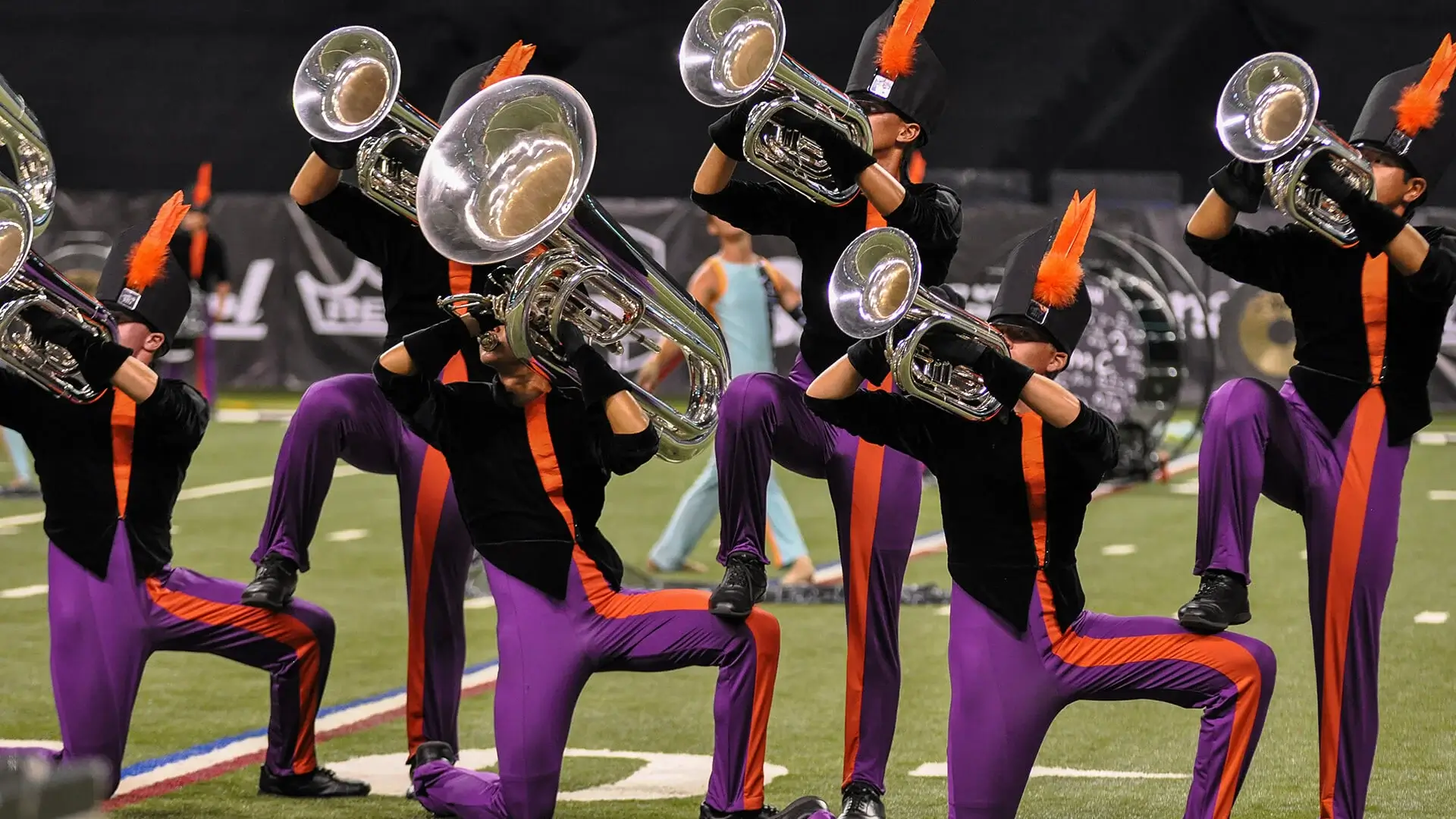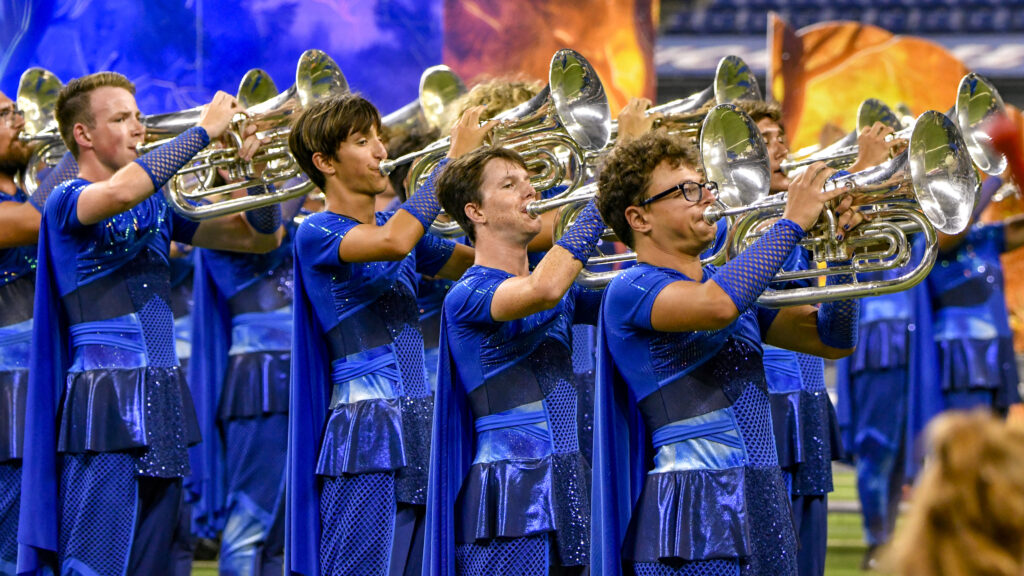At the 2013 Drum Corps International World Championship, Carolina Crown earned a perfect score in the Brass Performance caption on way to winning its very first World Class championship title.
Blue Devils finished only a quarter of a point behind by exploring Stravinsky’s “Rite of Spring” in the year of the masterpiece’s centennial, and The Cadets’ Samuel Barber show held off Santa Clara Vanguard’s disappearing act in “Les Miz” by a tenth of a point to capture third place.
In ninth place, Madison Scouts celebrated 75 years of brotherhood, and Blue Stars returned to the Finals competition after falling out of the top 12 the year before.

Carolina Crown’s “E=mc2” paid homage to the stunning mind of Albert Einstein, Time Magazine’s “Person of the Century.” The show was inspired by Einstein’s theory of general relativity, published in 1915, which turned the known world of physics on its head. Crown initially turned heads in its own way, with the unlikely color of the corps’ uniforms, earning the group the affectionate nickname, the Purple Pants Band.
Broken into the four movements, “Discovery,” “Energy,” “Obsession: Mass…Attraction,” and “Speed,” several visual “Easter eggs” were seen throughout the production. These included Einstein’s “E=mc2” equation, a moving sine wave, the infinity symbol, an exploding nuclear bomb, shimming light rays reflecting off a droplet of water, a water molecule complete with one proton in each hydrogen atom, and a rotating 3-D prism.
“Discovery” presented the quest of the show, celebrating the discoverer and his discoveries, commencing with a recitation from one of the “Knee Plays” from “Einstein on the Beach,” a 1976 avant-garde opera by Philip Glass. Vocalists up front recited an abstract poem and repetitively counted numbers to get things started, anticipating a fanfare that followed that sailed over the proceedings.
This led into the theme from “Also Sprach Zarathustra,” an 1896 tone poem by German Romantic composer Richard Strauss. The piece was generally not considered one of Strauss’ most famous works until the 1968 release of Stanley Kubrick’s “2001: A Space Odyssey,” in which the fanfare played a starring role in the beginning and end of the film. Individual Carolina Crown brass players ran out of a block formation up front to form a giant infinity sign, followed by the formula, “E=mc2,” as if written by Einstein’s hand.
The next section, “Energy,” was powerful and radiant. It was based on Philip Glass’ “Knee 5” from “Einstein on the Beach,” which included repetitive recitation of numbers, and Paul Lovatt-Cooper’s “Walking With Heroes,” a brass band piece from the early 2000s.
Starting with the sounding of various timepiece alarms, including the chimes of Big Ben, the arrangement featured otherworldly rapid sets of brass runs from the center of the piece, with the pulsation of the vocalizing repetitive numbers of the Glass piece occasionally heard over the music.

“Obsession: Mass…Attraction,” following the relentless pursuit for understanding, introduced a human element via a love poem literally interpreted with a color guard duo sitting on a park bench. The love story, from a poem that is part of “Einstein on the Beach,” was superimposed over Alan Silvestri’s “Main Title” from “The Abyss,” the theme from the 1989 underwater science fiction film of the same name.
This highly emotional piece ended with the phrase, “Everything must have an ending, except my love for you,” which tugged at the audience’s collective heartstrings unlike anything before or since.
“Speed” incorporated Paul Lovatt-Cooper’s “The Light Fantastic,” a brass band piece that encapsulated the grandeur of spirit of the Olympic Games. Color guard flags of different colors complemented the purple hue of the uniform pants.
The gist of the theme of the closer suggested achieving the speed of light, the idea of which inspired a much-talked-about drill formation of a rotating 3-D prism. This was said to reflect on Einstein’s famed 1905 paper on light refraction.
A few moments of “Knee 5” and Paul Lovatt-Cooper’s 2006 “The Dark Side of the Moon” brought the corps to the front of the field, where a reprise of “Also Sprach Zarathustra” led into the drill formation depicting a water molecule with the protons in each hydrogen atom.
The corps’ iconic crown drill formation took shape during an encore of the narration of “Everything must have an ending, except my love for you.” It was one of the greatest punches to the gut in drum corps history. The emotion sucked the air out of one’s lungs as identical sets of lovers appeared 40 yards from each other, the products of teleportation from within two large bass drums, showing that Einstein still had a few tricks up his sleeve.

Michael Boo was a member of the Cavaliers from 1975-1977. He has written about the drum corps activity for more than 35 years and serves as a staff writer for various Drum Corps International projects. Boo has written for numerous other publications and has published an honors-winning book on the history of figure skating. As an accomplished composer, Boo holds a bachelor's degree in music education and a master's degree in music theory and composition. He resides in Chesterton, Indiana.





